#Les ballets russes
Text
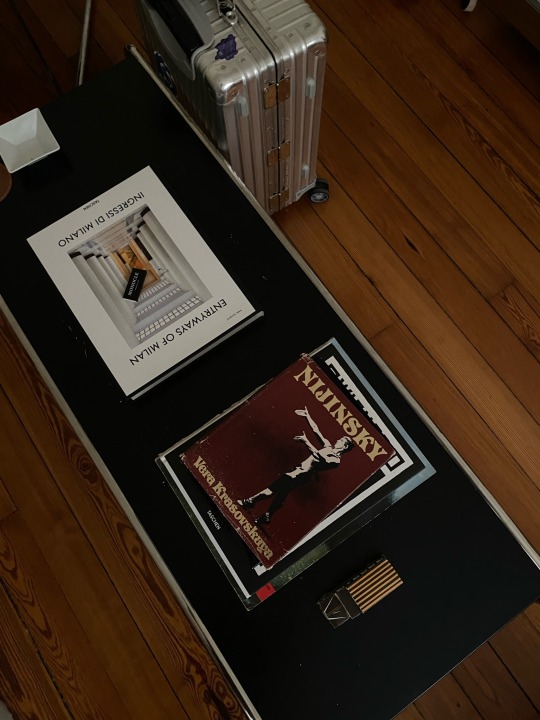
#inspiration#interiors#paris#marcel breuer#Breuer#rimowa#books#coffee table#coffee table books#taschen#nijinsky#vaslav nijinsky#Les ballets russes
11 notes
·
View notes
Text
It's so insane and funny to me that film directors of biopics feel the need to add fiction to make the film appear more interesting.
Like. why.
You don't need to come up with anything to make history more compelling.
WHY make anything up, when Friedrich Nietzsche had to buy fucking silk underwears for Richard Wagner once, Abraham Lincoln did wrestling, Victor Hugo lived in a street of his own name when he was alive, Alexandre Dumas fucking shut down a racist with an epic comeback, Edward VII had a sex chair, Tsar Nicholas II has nudes, Igor Stravinsky and Pablo Picasso were arrested for pissing in public together, Oskar Kokoschka commissioned an Alma Mahler fetish doll which he likely had sex with, Roald Dahl wrote some weird and questionable fetish-fanfic books, Salvador Dalí sold a blade of grass to Yoko Ono for $10 000 because he thought she could do witchcraft with a real strand of his hair, etc etc...
Do we REALLY need to make shit up when we have all these batshit stories. DO WE REALLY??????
#currently still experiencing whiplash after learning more about ballets russes dancers#and seing that at serge lifar's 1958 duel with marquis de cuevas the marquis' witness was JEAN MARIE LE FUCKING PEN#DJAKZJSBSJB#going insane#anyways#history#history nerd#history facts#fun facts#classical music#art#art history#music history#ballets russes#and there's still SO MUCH more#scherzina ramble
64 notes
·
View notes
Text
bom bom bom bom
bom bom bom bom
bom BOM bom BOM
bom bom bom bom
bom BOM bom bom
BOM bom bom bom
BOM bom bom bom
bom BOM bom bom
7 notes
·
View notes
Text



Costume from Ballets Russes Le Coq d'Or – designed by Natalia Goncharova, from the Stockholm Dansmuseet Collection
#ballets russes#le coq d'or#sergei diaghilev#dance#costume#twentieth century#1930s#fashion#dance costume#natalia goncharova
7 notes
·
View notes
Text

Serge Lifar and Félia Dubrovska in George Balanchine's production of Le Fils prodigue for Diaghilev's Ballets Russes, costumes by Rouault. From the July 1929 French Vogue.
(source: Gallica)
#ballets russes#diaghilev#serge lifar#félia dubrovska#ballet#1920s ballet#rouault#vintage fashion#george balanchine#le fils prodigue#the prodigal son#french vogue
19 notes
·
View notes
Text
blorbo from my academic field
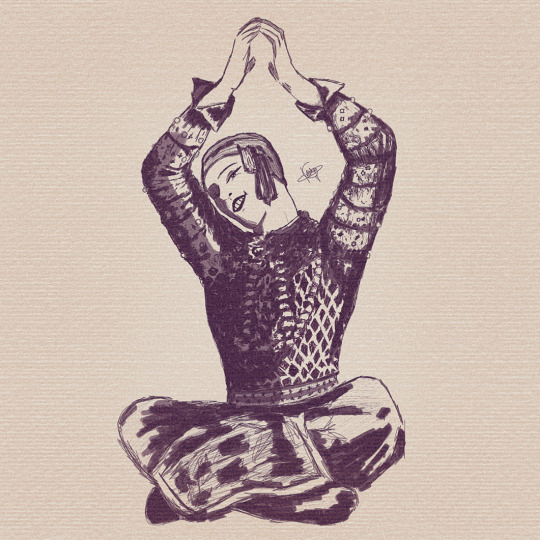
19 notes
·
View notes
Text
rewatched les noces. i cant imagine paying to see this live
#les noces#ballet russes i understand the grindset gotta capitalise on weirding ppl out on traditional russian shit +#weird choreo again but like man.#this does not spark the same joy as le sacre#also stravinsky's serialist ass was rlly up on the 12 tone shit for the music. respect my clout chaser#diaghilev 🤝 stravinsky#producing weird shit for the clout#ive never read on the production details for this one idk why nijinskaya decided to be weird#i think i mightve watched this last year too? i need to stop coming back to this ballet man. it does not get more.... legible(??)#i watch theatre
0 notes
Text
YOU ARE MARIA PLITZ
Here are the only photographed female dancers of the Ballet Russes’ first staging of Nijinsky’s Le Sacre du Printemps from 1913.After 4 hours of trying to tease out the real names even with Lynn Garafola and Millicent Hodson’s publications, I could not determine the actual names. Here is the best I could do.
Julitska (nope) Zhulitska? nope
Marie Rambert ding!
Jadwiga Jezierska (close…

View On WordPress
0 notes
Text
Les Ballets Russes Hermès© Scarf
Les Ballets Russes Hermès© silk scarf (100% silk twill) Designed by Annie Faivre in 1996/97 – AVAILABLE
From 1909 to 1929, Serge Diaghilev, the pyrotechnist of St Petersburg, galvanized Paris with his spectacles, which were a crackling fireworks display of all the arts. And there Nijinski was pushed to the pinnacle of his glory. At these triumphal heights, the god of the dance found only vertigo…

View On WordPress
#ancien hermes#authentic hermes#authentic vintage hermes#carre#carre de paris#carredeparis.com#hermes#hermes carre#Le Carré HERMÈS© – Paris Fall-Winter 1996/97#Les Ballets Russes Hermès© Scarf
1 note
·
View note
Text
Egyptian Revival
Yesterday's post was about the full opening of Tutankhamun's tomb, but there have been several times when Egypt has had a strong influence in fashion and art, and here I selected a few things from the 1910s and 1920s that are Egyptian revival, and of course let me know which ones are your favourites of you can add some when reblogging this post.
Here we go.


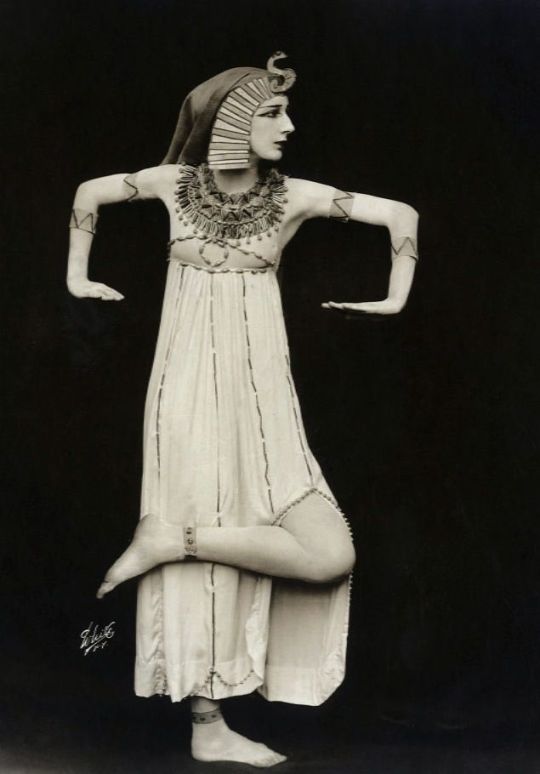
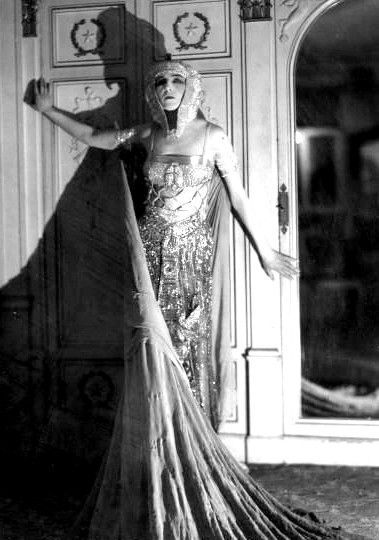

The beginning of the century marked the birth of modern dance, so we see that part of the Orientalism trend had a deep Egyptian influence from Les Ballets Russes to the Denishawn school: strong lines, profile poses, spectacular costumes, all taken from the art and sculpture of the ancient Egypt.
Here a little video of the Denishawn dancers along Ted Shawn (not the dance of the picture above), with no music because this is FROM 1913:
youtube
Also, this influence is clearly seen in the art deco masterpiece that is the dance scene from Metropolis (1927):
youtube
Denishawn students (Lillian Powell, Charlotte Brendel, Grace McCrea, Irene Pryor, Claire Niles) in an Egyptian dance created as part of a vaudeville act by Ted Shawn (not related to the Denishawn Egyptian Ballet), Hixon-Connelly, 1918, The New York City Public Library.
Vaslav Nijinsky and Serafima Astafieva in "Cleopatre", probably by Ernst Sandau, 1912, National Portrait Gallery, London.
Desiree Lubovska as Cleopatra, ca. 1915.
Ida Rubinstein with costume designed by Erté, 1920s.
Dancers from the Folies Bergère with costumes designed by Erté, Paris, 1924.
Dance of the Priest of Ra, from Dances of the Ages, Denishawn dancers, 1913.
Dance Scene, from Metropolis, Fritz Lang, 1927.






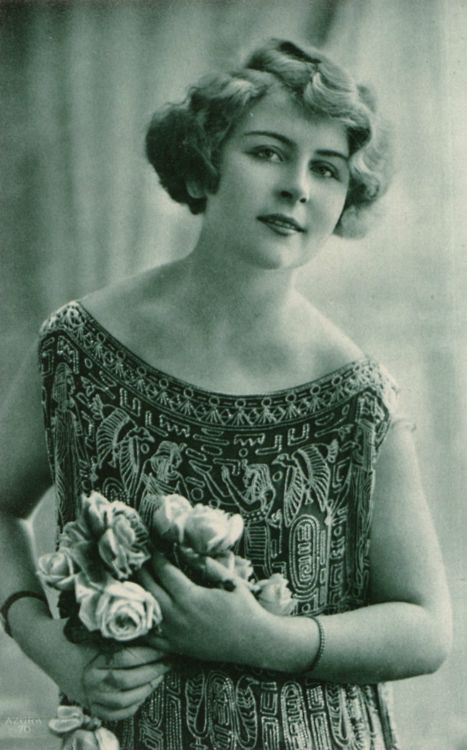
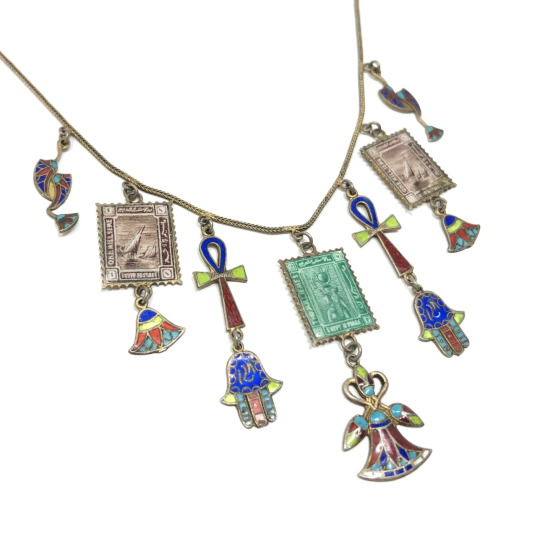
Fashion and accessories were deeply inspired by Egypt in the 1920s, thanks to the simple shapes of the garments, the use of striking accessories and jewelry, and the use of embellishments and embroidery to elevate the simple dresses: from appliqués to bead embroidery, to burnt velvet and translucent layers. And of course, let's not forget the use of colour that gives the feel of ancient Egyptian art: gold, sand, teal, royal blue, and burnt orange.
Orange burnout velvet dress, 1920s, available in Antique Graces.
Egyptian revival brooch, Max Neiger, 1920s, sold at auction.
Egyptian revival silk dress with appliqués, 1920s, Stephens College Costume Museum.
"Cleopatre" grande robe du soir by Jean Patou, Les Modes, september 1921 (click that link! You can read the whole magazine!).
Evening dress, Thurn, 1923-26, Metropolitan Museum of Art.
Pair of leather gloves with silk embroidery, ca. 1925, LACMA.
Beaded Egyptian revival dress, 1920s.
Egyptian revival silver gild and enamel charms necklace, 1920s, on sale on etsy.
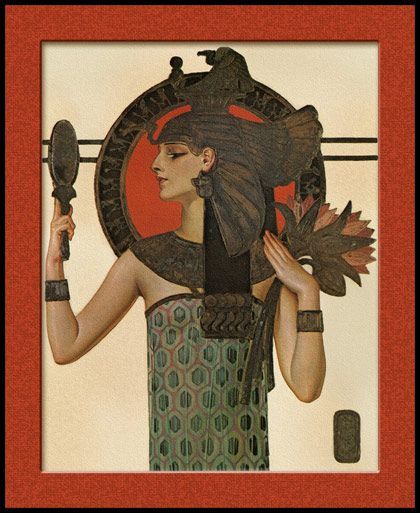
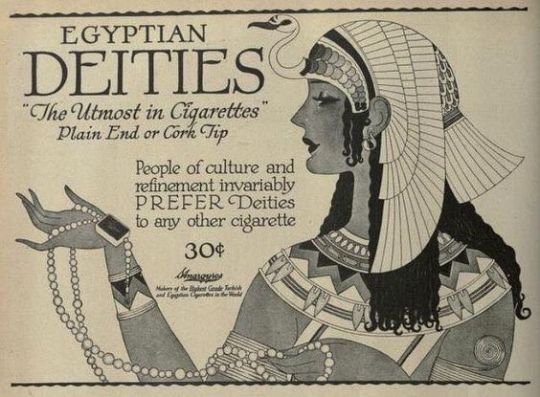


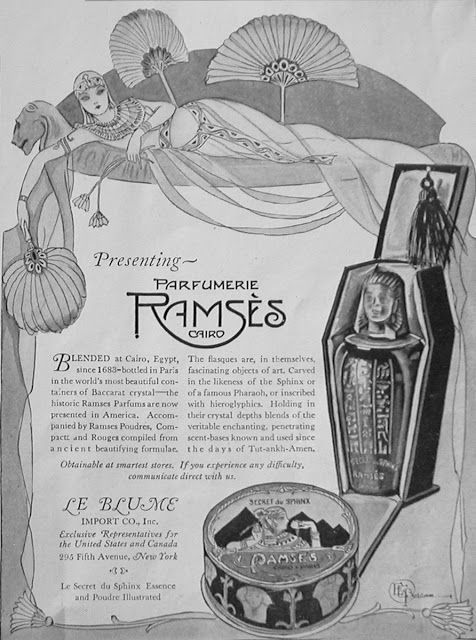
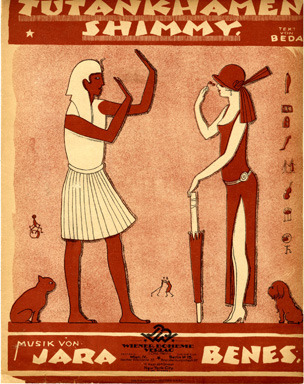
Of course, let's not forget the graphic arts. illustration was a key for advertising and communication when colour photos were not available. Here a small selection of my favourites:
"Cleopatra", J.C. Leyendecker, for the cover of the Evening Standard, August 1923.
Ad for Egyptian Deities cigarettes, 1920s-30s.
Egyptian Goddess, ca. 1929, George Barbier.
Ramses perfume ad, 1923.
Cover for Harper's Bazaar, February 1927, Erté.
Music sheet cover for the Tutankhamen Shimmy, 1923.
And finally an extra: a Tutankhamen shimmy recorded in 1926:
youtube
#1920s#1910s#1900s#egyptian revival#fashion#music#dance#fashion history#dance history#art#egypt#Youtube
229 notes
·
View notes
Text















"Have One On Me" comparison :
-Ida Rubinstein and The Russian Ballet-
As Joanna said in an interview, a model in a some parisian art studio around 1920 in Paris (France) is one of the inspirations for the HOOM cover photo. Here we have the model, the painting and even photographs. The oriantal "odalisque" like pose is in there and a strong chinese screen that reminds me of course the one on the "Have One On Me" picture. We have less elements in here for making a comparison, but strong elements, as the same posing and background. So, maybe an other reference sources, maybe . . . Ida Rubinstein was a famous dancer, known for her work with the no less famous russian dance compagny : "Les Ballets Russes". Quite a sensation in Paris in the 1910's. An explosion of colors and energy with a lot of of exotic oriantalism coming from the east. Here she is depicted as her caracter Zobeide from the Sheherazade ballet, costume designed by Leon Bakst. The paintings was made by Jacques Emile Blanche. Also depicted, with the same chinese screen background her fellow dancer Vaslav Nijinski.
#joanna newsom#have one on me#have one on me comarison#art#paris france#ida rubinstein#ballets russes#leon bakst#vaslav nijinsky#jacques emile blanche#HOOM
19 notes
·
View notes
Note
What's a ballet with real snazzy costume work, in your humble and/or professional opinion? c:
Oh, you’ve activated my trap card - asking about costume design and ballet and not expecting me to barf up the entirety of my PhD. I’ve also done work on the ballet blancs costumes (Giselle and La Sylphide specifically) but they are interesting on a theoretical level and not so much visually, so I’ll skip that.
So here are some personal favs of mine - the highlights, if you will. Caveat: long post, and mostly limited to the work of the Ballets Russes, because they are my longtime obsession and I think (and have argued) for their role in fundamentally changing stage and costume design (to say nothing of dance, and George Balanchine can sit the fuck down). I didn’t put that in my thesis but I wanted to.
Anyway tldr in the first decade of the 20th century a troupe of dancers from the Russian Imperial Ballet (later the Mariinsky) travelled through Europe under impresario Serge Diaghilev, for what became known as the Saisons Russes, or Russian Seasons. They performed both opera and ballet, and are probably best remembered today (if at all) as the troupe that danced the premier of Stravinsky’s Rite of Spring and caused a riot at the Theatre des Champs Elysées. The eminent artists that worked with them include Debussy, Cocteau, Picasso, Chanel - and these are only a few recognisable names. But my focus was primarily on the Russian roots of the ballet, in their visual language and presentation of gender and nationality, more precisely around the work of artist Leon Bakst and dancer Vaslav Nijinsky.
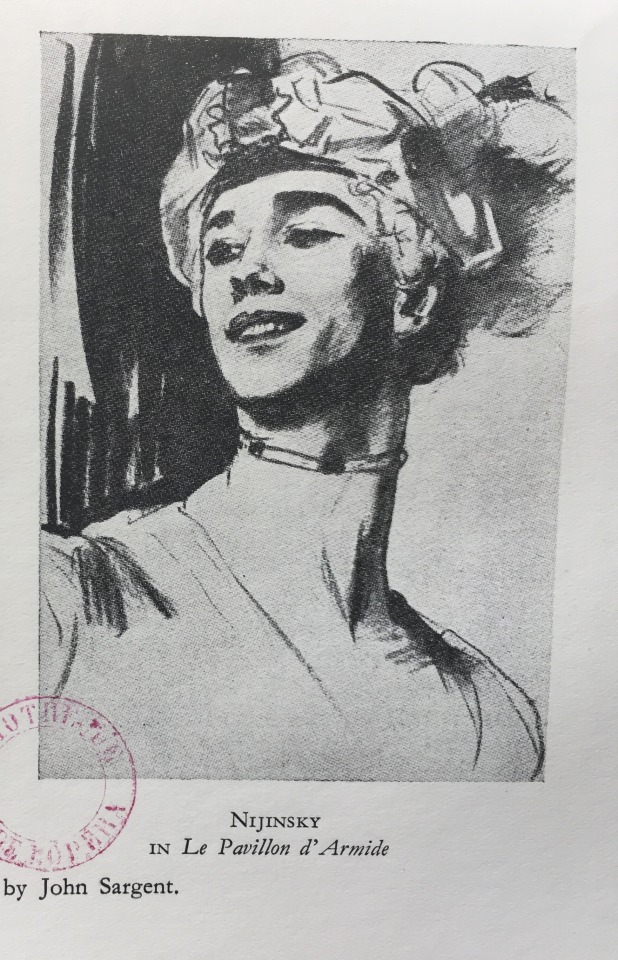
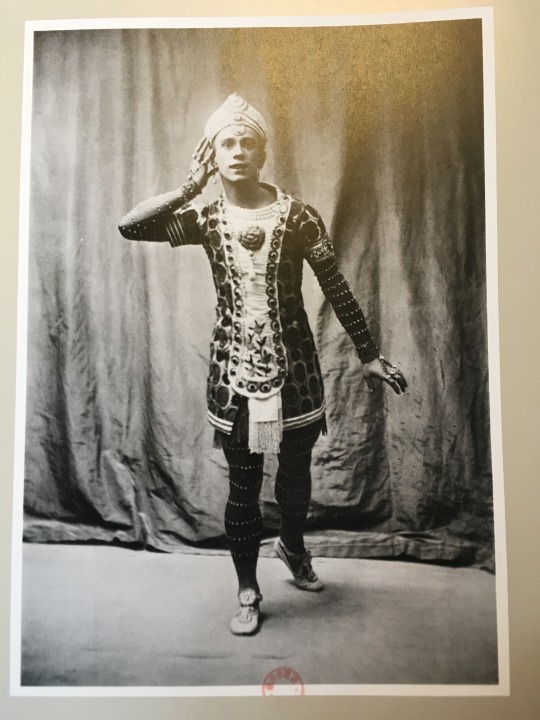
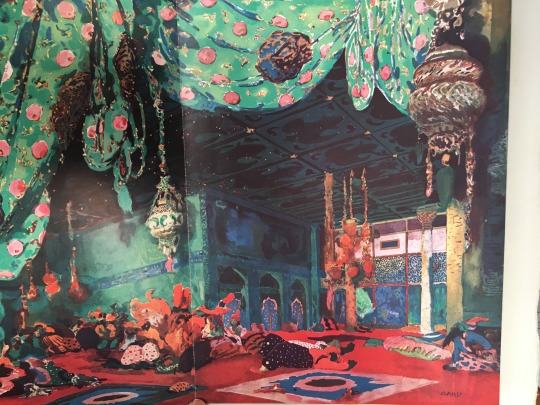
Second image of Nijinsky from Le Dieu Bleu, and Bakst’s set design from Scheherazade (1911). These are mainly photos and scans I have from the year I spent in the archives of the Palais Garnier (the Paris Opera) where all the good stuff is.
The crux of why these costumes are insanely interesting to me is because they are very specific to their time - they are a product of a resurgence in nationalist interests in Russian art (Diaghilev ran Mir Isskustva and worked with Savva Mamontov before he organised the BR) as well as a carefully crafted, highly artificial presentation of Otherness, expressly destined for export to the west. French audiences in the first decade of the 20th century (because there is a stark cut-off at the beginning of WW1) still had an appetite for Orientalism, despite their flagging colonial power. What the Russians brought them was compelling mix of performative Orientalism just vague enough to be appealing and fantastical, visually intriguing, and refreshing to a society that had otherwise come to recognise itself as decadent, fallen “victim” to modernity. In the athletic virtuosity of Russian bodies, Bakst’s exotic visual language and the soaring music of Rimsky-Korsakov and Stravinsky, the French devoured what they deemed a sort of noble savagery (yes, that kind). Despite the oversaturation of Orientalism in painting throughout the 19th century, the French identified a kind of masculine vigour and freedom in these live performances they found they themselves lacked, and longed for. Primitivism, as demonstrated in myriad ways by the BR, was for them a way to reconnect with a virility that they felt modernity had stolen, or at the very least, weakened. If you think this sounds eerily akin to the discourse around mounting desire for war to “cleanse” or “reset” Europe during that same period, you are right.
A few of Bakst’s lesser known designs from the archive, for context (including a reprod by Barbier which I don’t have the OG of but is saved in my Bakst folder so please take my word for it). I have a thousand more of these but tumblr has an image limit per post 😤

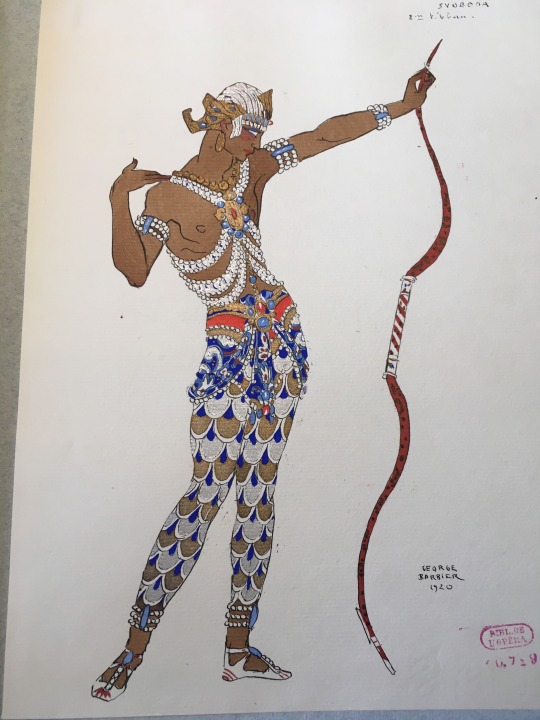

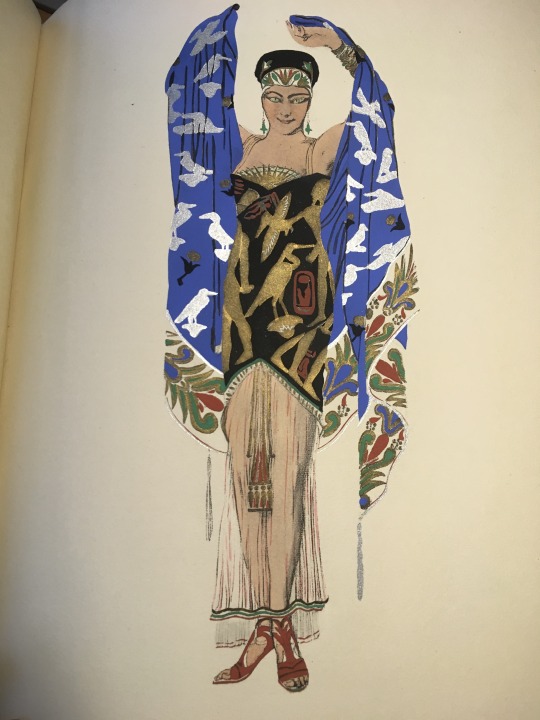

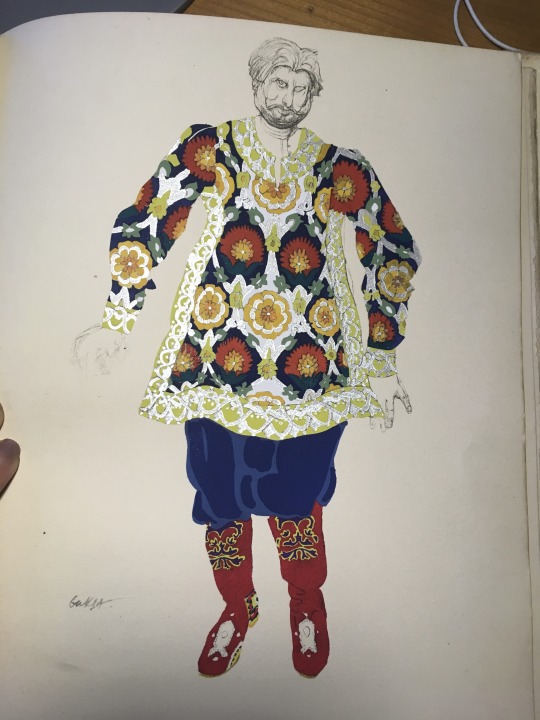
Tamara Karsavina, who often performed with Nijinsky, and one of my most beloved historical figures. The existence of a strong classical ballet cirruculumin the UK today is in part thanks to her.

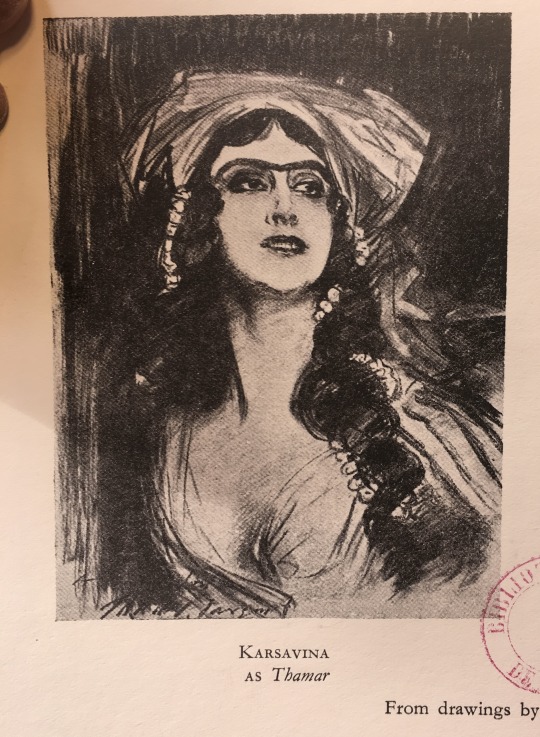
One of her most famous roles, as the Firebird:
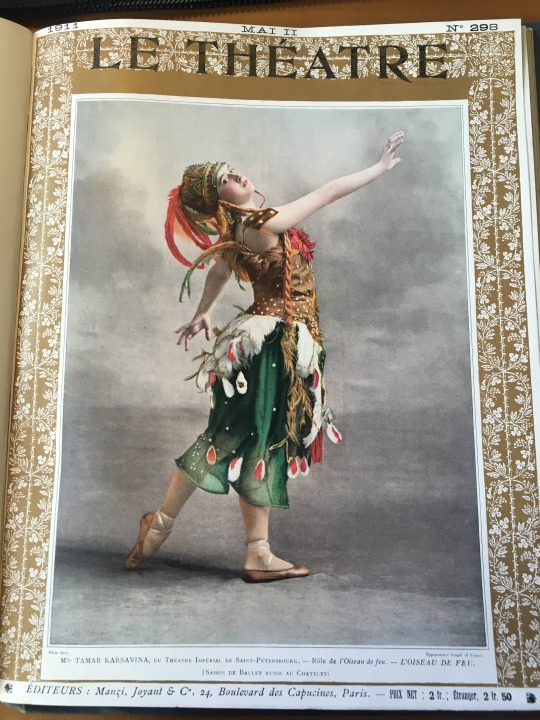
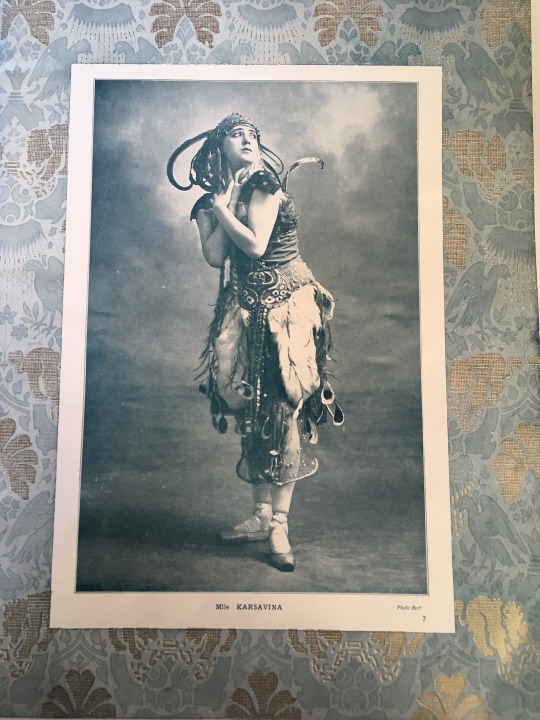
Nijinsky is by far the most interesting figure to come out of the BR. He combined virtuosity and strength (that most audiences identified as masculine) with a glittering, joyful, and expressive queerness on stage (and off). Some of his greatest roles are expressly feminine in their costume design: Le Spectre de La Rose, for example.
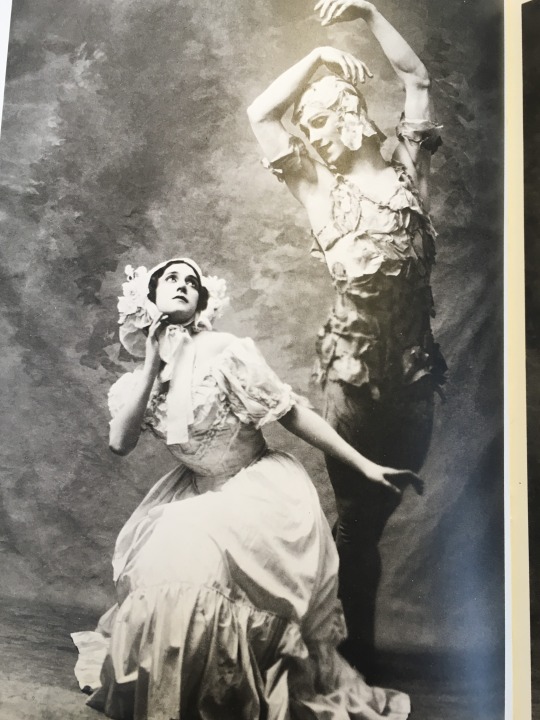
There’s a colorised version of this out there where you can see every pink rose petal on him.
While others are much more decorative but still markedly Orientalist (or Russian-Orientalist): Le Dieu Bleu, La Peri, Les Orientales, L’Oiseaux de Feu.

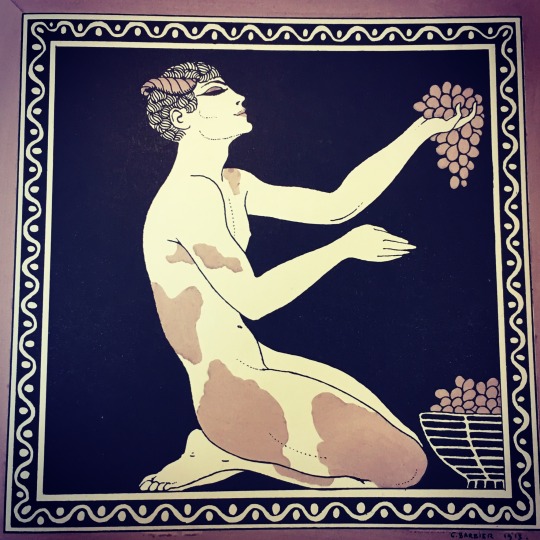
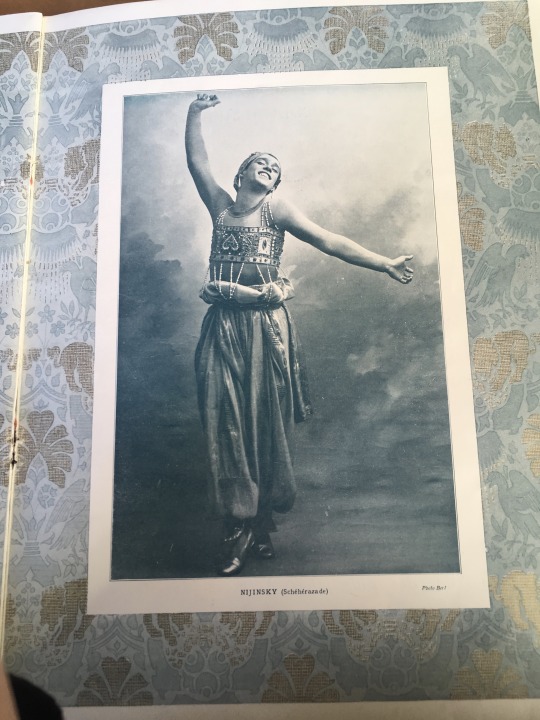

This last image above is not, the last I saw it, in a private collection. It hangs above the vestibule of the Palais Garnier archives (also Napoleon’s private hangout room) where it faces the sort of “diptych” version that features Karsavina, and on occasion I would stand below them and weep quietly).
Either way, there is an argument to be made about Nijinsky’s physicality and, more importantly nationality as a kind of avenue of permission through which the French could admire both his beauty and athleticism and even, to a degree, imagine themselves in his place while still maintaining that safe distance of Otherness.
But I would argue that his greatest role was the Golden Slave in Scheherazade, a wild, erotic orientalist fantasy that has little to nothing to do with the actual tale of Scheherazade. In it, Nijinsky - bejewelled, wild, ecstatic, (and yeah often in blackface) - cavorts with Zobeide, the Sultan’s favourite, in a very sexually explicit storyline. Both characters are equally decorative in their costumes, and both, in real life, were recognisably queer(ed) figures. It’s Scheherazade in particular that helped accelerate an obsessive trend in fashion (Paul Poiret was at the centre) for Orientalist design. Bakst himself did some silhouettes that are hard to distinguish from his costume design, and through the remarkable illustrations by Paul Iribe, Georges Lepape and Georges Barbier, we can see some of the blatant repetition of motif and silhouette in these ensembles that are designed, among other things, to be worn to the theatre.
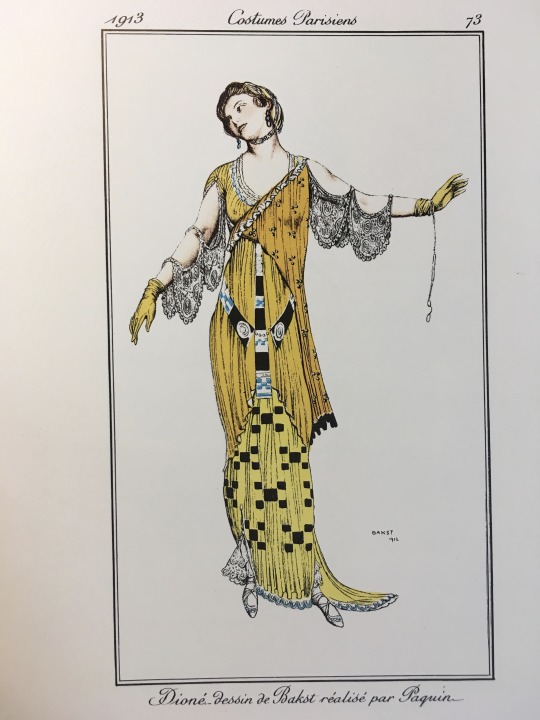
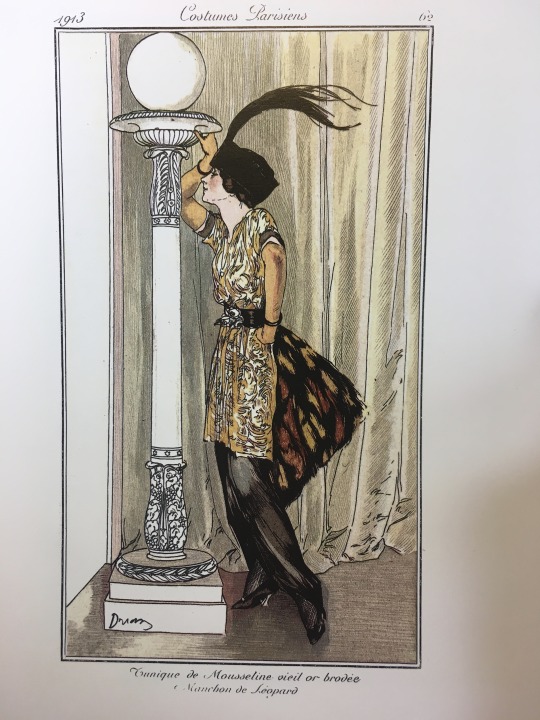
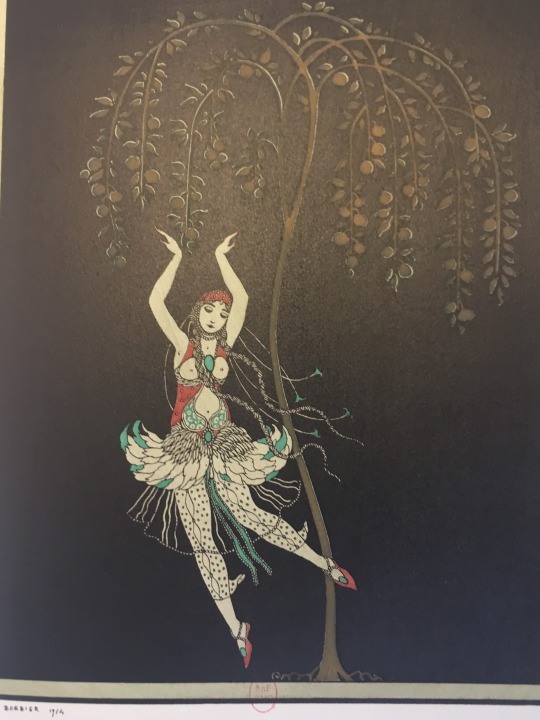
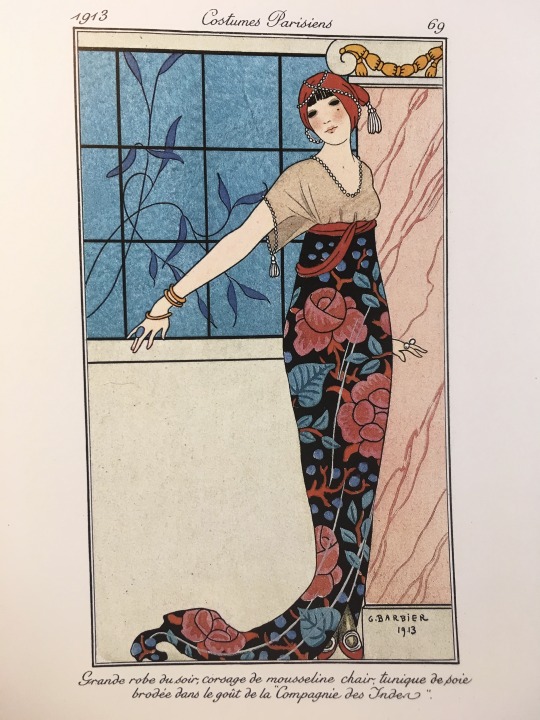
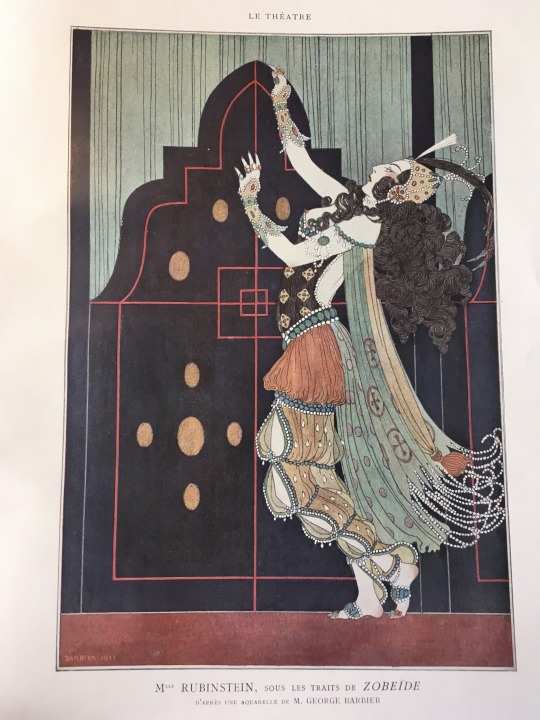
3rd and 5th are depictions of costumes of the Firebird and Zobeide respectively; the rest are fashion plates. This doesn’t even include the lampshade dress - which I don’t have a handy picture of, but have seen in real life - that is a pretty blatant melange of the Firebird and Zobeide, as designed by Poiret. Below is one of my favourite examples: A woman in a lampshade-style dress, standing against a backdrop not unlike Bakst’s set design above, attended by a archetypal oriental servant wearing Nijinsky’s Golden Slave costume.
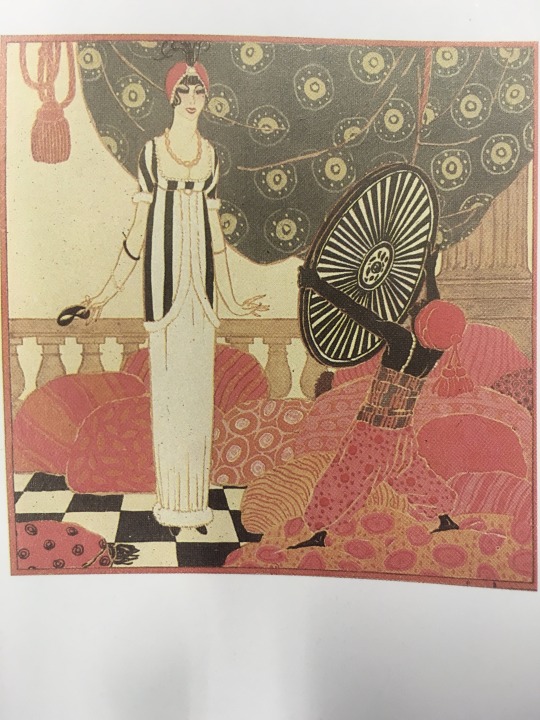
These motifs also proliferated in advertisements and in all kinds of other consumer products (perfumes, for example, and decorative objects). Thus, there’s a performative aim in wearing these designs that I read as a sort of pseudo-kinetic empathy (and can funnnily enough probably be compared to cosplay). There is an attempt here to channel what is being presented onstage, to reenact it, to physically embody it, in the way that fashion is, at its core, a tool through which to construct identity. That the French pulled inspiration from an openly queer man leaping across the stage dripping in jewels, and from femme fatal-style odalisques, says a lot about the visual and cultural impact the BR had on the theatre-going public at the time.
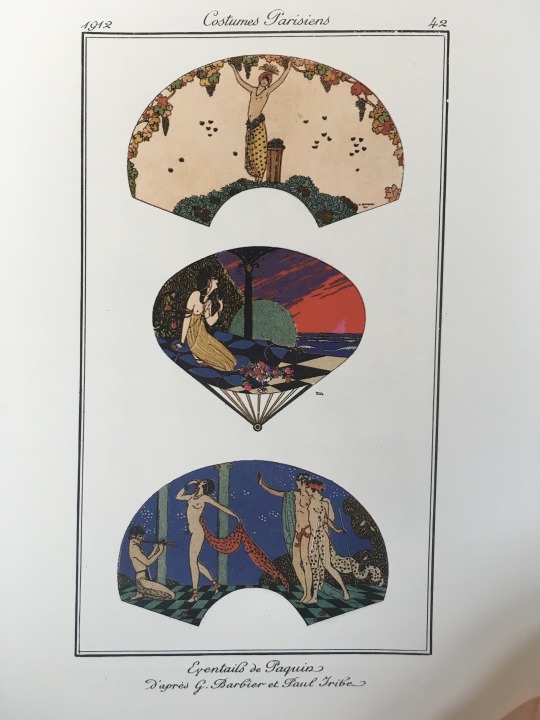
You can see in these fan designs by Paquin some pretty obvious references to the BR aesthetic: L’apres-midi d’un faune, Daphnis et Chloe, Scheherazade, even a little Le Pavillon d’Armide in that first one.
Nijinsky was not the only one to queer the stage: despite not being a dancer trained to the level of the BR troupe, Ida Rubinstein, no doubt purposefully channelling Sarah Bernhardt, was also a beloved stage presence, whether as the sly harem favourite Zobeide or as the strikingly androgynous St Sebastian, gayest of saints.

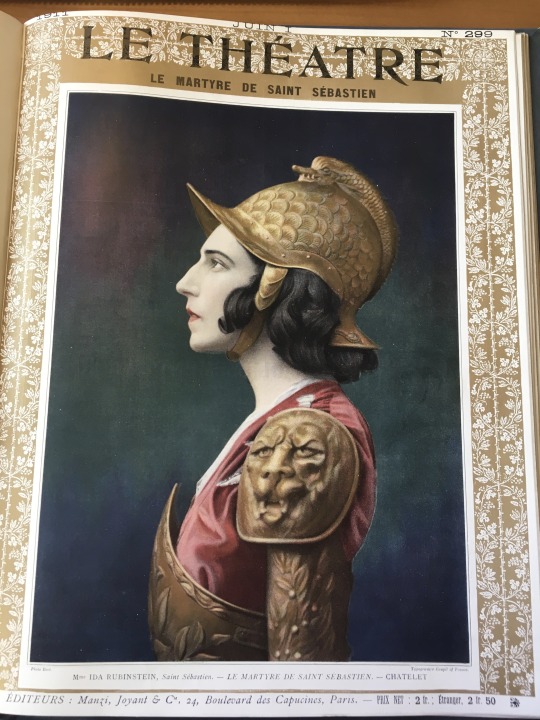
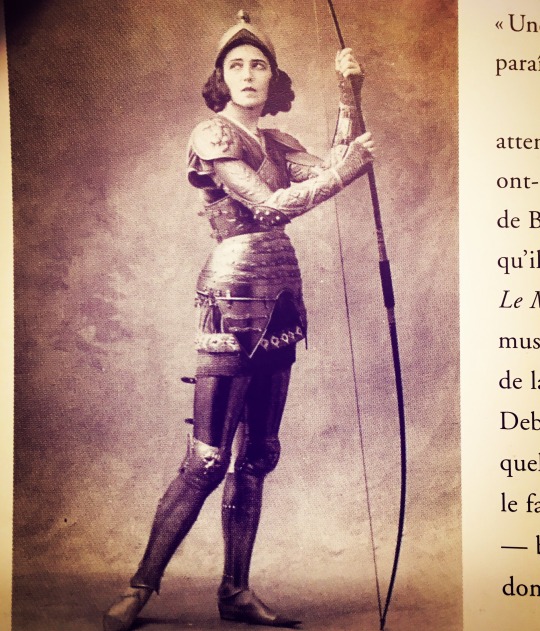
This is not to say there haven’t been wonderful and brilliant costume designs since - and quite a few known fashion designers working alongside dance companies, to great success or otherwise. I will, however, shoutout my favourite contemporary work: Akram Khan’s Giselle, which has everything and yet nothing to do with Adolph Adam’s 1842 piece. I don’t even want to post pictures because the costumes of the nobles (the landowners, in this very apocalyptically late-stage capitalist version) are so fucking breathtaking in relation to the overall design, and their entrance itself is probably one of the most spectacular parts of the ballet, that all I can say is just see it. Or buy the dvd. What Khan does gesturally is beyond words, what Vincenzo Lamagna does with Adam’s original score is visceral and haunting and churns my insides. I make a point to see it live at least once a season when it’s touring with the ENB, and I will do so until it leaves the repertory or until I die. It’s my contemporary Scheherazade. It’s a gesamtkunstwerk.
Tldr Leon Bakst is one of the greatest costume designers of the 19th and 20th century and criminally underrated.
It’s not ballet, and it’s not the sumptuous costumes from Boris Godunov, but as a bonus here’s my favourite image of opera star Fedor Chaliapine as Ivan the Terrible.
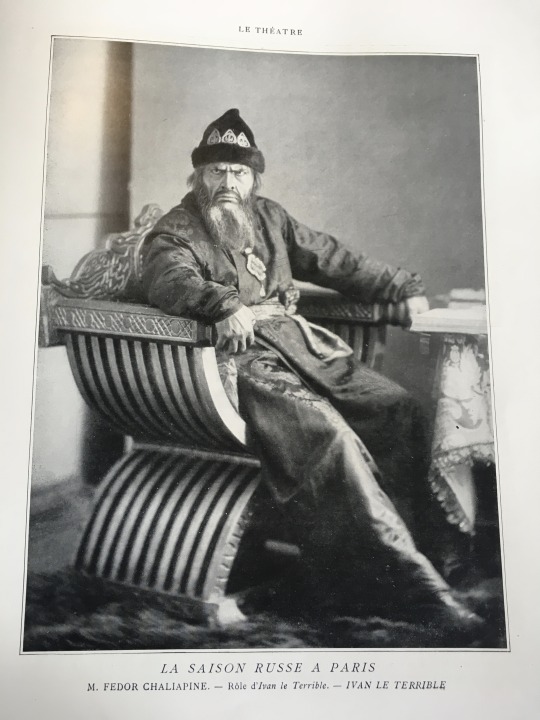
#Thank you for the enclosure enrichment#And for coming to the tldr of my thesis#ballets russes#vaslav nijinsky#Leon bakst#fashion design#academic indulgence hour#Art history
52 notes
·
View notes
Text
Realistically it would make sense that all three darlings of the Moriarty brothers can speak French as well as English, just hear me out on this one.
Albert’s darling comes from aristocracy and I believe I said somewhere before that her grandparents live in Paris and she has friends who live in France, so it would only be natural that she was taught it at a very young age by some language teacher or her parents.
Louis’ darling went to college and has a Ph. D in library science, and I would imagine she has definitely taken language and linguistics classes so she probably speaks quite a few languages, French, Latin, Russian, and maybe Italian.
Then William’s darling used to work at the ballet and from the author’s own experience in ballet, I learned conversational French from doing ballet with the terminology of it so I imagine William’s darling would have learned a bit as well via her old job.
So I am just imagining whenever they don’t want the brothers listening into their conversations or they are mad at them they just speak in French to one another so they can’t understand like…
"Combien de temps pensez-vous que nous pouvons continuer à faire ça jusqu'à ce que l'un d'eux décide d'apprendre?"
"hm… deux mois."
"Non, je dirais quelques semaines, William l'a mentionné ce matin lorsqu'il parlait à Albert avant son départ."
"Peut-être que je devrais t'apprendre le russe alors."
"absolument pas."
Meanwhile the three brothers are just watching them from across the room.
#william moriarty x reader#moriarty the patriot x reader#yuukoku no moriarty x reader#yuukoku no moriarty#william james moriarty x reader#yandere william james moriarty#yandere moriarty the patriot#yandere yuukoku no moriarty#yandere albert moriarty x reader#yandere albert james moriarty x reader#yandere albert james moriarty#louis james moriarty x reader#yandere louis james moriarty#yandere louis moriarty
8 notes
·
View notes
Text
The Morgan Library & Museum
Crafting the Ballets Russes
The Robert Owen Lehman Collection

Crafting the Ballets Russes: The Robert Owen Lehman Collection
June 28 through September 22, 2024
Robert Owen Lehman’s extraordinary collection of music manuscripts has been an inspiration to scholars and visitors since it was placed on deposit at the Morgan Library & Museum. Among its many splendid works are deep holdings of early-twentieth-century ballet, including Igor Stravinsky’s Firebird (1910), Petrouchka (1911), and Les Noces (1923); Claude Debussy’s L’après-midi d’un Faune (1912); and Maurice Ravel’s Bolero (1928) and La Valse (1920).
The exhibition opens with the dramatic arrival of Serge Diaghilev’s Ballets Russes troupe in Paris in 1909 and goes on to trace its impact across the arts, highlighting the rise of women in leading creative roles. They include Bronislava Nijinska, who in 1921 became the Ballets Russes’ only female choreographer and whose groundbreaking choreography defined Les Noces, Bolero, and other ballets of the era; and Ida Rubinstein, whose riveting stage presence helped establish the Ballets Russes in its first seasons and who came to rival Diaghilev as a patron of music, commissioning Bolero in 1928.
At the core of the exhibition is the creative process that brought these ballets to life. The exhibition and accompanying catalogue address the sketches, drafts, and working copies of the composers, choreographers, and designers, capturing the ways in which they imagined, conceived, and collaborated to kindle works of astonishing originality and ongoing influence.
The exhibition is organized by Robinson McClellan, Assistant Curator of Music Manuscripts and Printed Music.
Crafting the Ballets Russes: The Robert Owen Lehman Collection is supported by the William Randolph Hearst Fund for Scholarly Research and Exhibitions, the Robert Lehman Foundation, Mr. and Mrs. Clement C. Moore II, the Lucy Ricciardi Family Exhibition Fund, Elizabeth and Jean-Marie Eveillard, Cynthia Hazen Polsky and Leon Polsky, and the Franklin Jasper Walls Lecture Fund. Assistance is provided by the Gladys Krieble Delmas Foundation and Hubert and Mireille Goldschmidt.
(L) Igor Stravinsky (1882–1971), Firebird, autograph manuscript, piano, extensive revisions, [1910]. The Morgan Library & Museum, New York, Robert Owen Lehman Collection, on deposit. Used by kind permission of European American Music Distributors Company, sole U.S. and Canadian agent for Schott Music GmbH & Co. KG, Mainz, Germany, publisher and copyright owner.
(R) Léon Bakst (1866–1924), “Firebird and the Prince (Tsarevitch),” poster design for Firebird, 1915. Harvard Theatre Collection, Houghton Library, Howard D. Rothschild Collection.



#. The Morgan Library & Museum, New York #art #original art #xpuigc
7 notes
·
View notes
Text
I believe the first ballet to A Midsummer Night’s Dream was Marius Petipa’s version for the Maryinsky Ballet in St. Petersburg in 1876. It was this that Michel Fokine in 1906 adapted and amended for students of the Imperial School. The cast included Vaslav Nijinsky, and it proved one of the very early works of Fokine to capture the attention of the impresario Serge Diaghilev. Fokine later reworked the score into Les Elfes for his own company at the Metropolitan Opera House in 1924. In 1933 Col. W. de Basil’s Ballets Russes de Monte Carlo staged David Lichine’s first ballet, Nocturne, using not Mendelssohn but Rameau music, with Alexandra Danilova as Titania, Léonide Massine as Oberon, and Lichine himself as Puck.
But the four most interesting versions for me are George Balanchine’s for New York City Ballet in 1962, Frederick Ashton’s for Britain’s Royal Ballet in 1964, John Neumeier’s for the Hamburg Ballet in 1977, and Christopher Wheeldon’s for the Colorado Ballet in 2000. All, except for the Ashton, are full-evening ballets. Wheeldon’s version not unexpectedly owes something to both Ashton and Balanchine. Neumeier’s version—which is by far the most adventurous and original and incorporates modern music by György Ligeti—has also been staged by the Paris Opera Ballet and the Royal Danish Ballet.
#shakespeare#william shakespeare#dance#ballet#shakespeare and dance#balanchine#midsummer#a midsummer night's dream
9 notes
·
View notes
Text
so im working on a pretentious, i mean, JP themed playlist, and i really wanted to throw in a composer with the same initials as a joke
which is why Johann Pachelbel and Jean-Philippe Rameau have infiltrated this playlist despite having no other relevance to his character;;;
speaking of, here's what i got so far:
J. Pachelbel - any fugue, just... anything that isn't Canon in D
J.P. Rameau - Les Indes galantes, Forêts paisibles
(but this rock cover specifically)
Sergei Prokofiev - Romeo and Juliet, No. 14 Dance of the Knights
(stolen from another JP playlist you know who you are lmao. it gets bonus points for being from a ballet)
Sergei Rachmaninoff - Piano Concerto No.2 in C minor, Op. 18
(there's a reason it's popular!! and i like the strings in it!!)
Dmitri Shostakovich - Waltz No.2
(another popular one. it's a pretty tepid choice i admit)
Nikolai Rimsky-Korsakov - Scheherazade, Op.35
(this one's pretty well known too. apparently there's optional yelling in the 4th movement?? gets bonus points for being a ballet)
Aram Khachaturian - Masquerade Suite
(another popular one, especially the Waltz, which fits him rather well. though i also like Nocturne and Mazurka. apparently there's a ballet of this so that's bonus ballet points)
Khachaturian - Gayane, Sabre Dance
(I'M KIDDING. but a JP hater would have chosen this)
Khachaturian - Gayane, Dance of the Comrades
(since i do not hate him, i'm replacing the previous with this from the same ballet. and ofc, bonus ballet points)
Pyotr Ilyich Tchaikovsky - The Nutcracker, Arrival of Drosselmeyer
(there was a whole thing on Twitter about how JP's smile resembles a nutcracker, so this was obvious. Uncle Drosselmeyer as a character is rather JP-esque as well, at least, when he's pretending to be nice)
Alexander Mosolov - Iron Foundry
(referenced in JP's win quote to Zangief: "Seeing you, I can't help but recall Mosolov's Iron Foundry, tovarisch.")
Mosolov - Two Nocturnes, Op. 15
(it's really unsettling! and reminded me of JP's introduction scene in World Tour, with the horror elements)
Igor Stravinsky - The Firebird, The Infernal Dance of King Kastchei
(bonus ballet points, and for sharing names with his j.HK)
(honorable mention to Petrushka, another ballet, but it isn't exactly 'JP'. but i like Danse Russe so, i'm mentioning it lmao)
Alexander Scriabin!!! - everything!!!
(recently discovered for me and im in love. there's a whole collection made by Dmitri Alexeev of all his works, and i can totally see JP doing paper work with it playing in the background)
this list is already too long, but here are some extra notes:
Rimsky-Korsokov was part of 'The Mighty Five', also including Modest Mussorgsky, Mily Balakirev, Cesar Cui, and Alexander Borodin. This was a historically and musically significant group, which is why I wanted to at least name drop them.
Actually, it was looking into Mosolov that sent me down the rabbit hole regarding similar Soviet-era composers. Obviously there's a lot going on here with the... artistic (and political) censorship at the time.
Or, all of interesting stuff going on with composers finding influences from traditional folklore/ dances. Or alternatively, responding to and processing contemporary events through music, as a form of subtle protest...
But I've only glossed over these topics so I'm going to refrain from going too deep on it;;
As for connecting all this to JP, gosh idk, these comic pages from Vol. 3 and 4 seem relevant. I'll let these stew as a final thought:

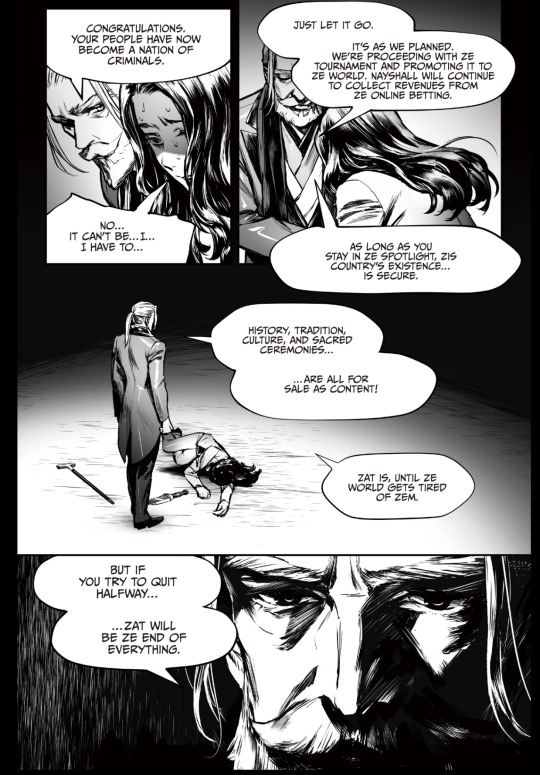
#jp rambles#maybe i shouldve made an actual playlist with videos#but i did NOT do that haha#have fun looking them up
13 notes
·
View notes